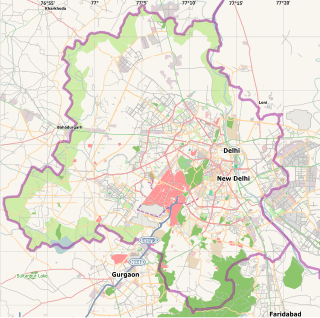Kirari Suleman Nagar
Kirari Suleman Nagar Popularly known as Kirari Village.[1]
Kirari Suleman Nagar Kirari Village | |
|---|---|
 Kirari Suleman Nagar Location in Delhi, India | |
| Coordinates: 28.6968°N 77.0644°E | |
| Country | India |
| State | Delhi |
| District | North West Delhi |
| Languages | |
| • Official | Hindi,English |
| • Mother Tongue | Haryanvi |
| Time zone | UTC+5:30 (IST) |
| PIN | 110086 |
| Civic agency | North Delhi Municipal Corporation |
Kirari is an urban village which lies in the North West Part of Delhi, originally created by Jat people[2], the surrounding area and some parts of the village itself are now heavily urbanized and Industrialized although town has grown a lot in a past few years but the culture and spirit of the village with which it was established still exists.
Kirari is diverse and united today with friendly people and their helpful nature, it is seeing development faster than it has ever seen before and eventually is growing into a successful town.
Big waves of migrants from Bihar and UP came in 1990s to 2020[3]. Alot of migrants are now settled around the parts of the village they are hard working and prospering in almost every field including politics, the current MLA of Kirari is Rituraj Govind.[4]
History
On behalf of the state of Bharatpur, the Matsyavajas Jat Dheeraj Mathur and Natha Mathur were appointed to conduct the office of ruler of five villages named Karala, Pansali, Pooth Khurd, Kiradi, Hastasar near Delhi. The ruins of this office are still lying in Karala. Settled in Kakana village (near Gohana) from this village itself. In addition, Matsya-Matsar or Machhar Jats reside in the villages of Putta and Umarpur in Bijnor. Khetri village in the district Sikar of Rajasthan belongs to the Jats of Matsya or Machhar gotra.[5]
Kirari first officially appeared as (Khiraree) on the map found in the musty room of the National Archives of India which shows Delhi in 1807, shortly after the arrival of the British in 1803. It highlights the hierarchy of settlements, from small to larger villages.[6] We can further trace Kirari's natives genetics with the Indo-Aryan Migrations.[7]
Lateron Village Nithari was created from the Kirari.
Gallery
 (Khiraree) or Kirari in Sketch of the Environs of Delhi, 1807. National Archives of India[8]
(Khiraree) or Kirari in Sketch of the Environs of Delhi, 1807. National Archives of India[8]
Demography
As of 2012 India census,[9] Kirari Suleman Nagar has a population of 154633 (2001). Males constitute 55% of the population and females 45%. Kirari Suleman Nagar has an average literacy rate of 49%, less than the national average of 59.5%: male literacy is 51%, and female literacy is 38%. In Kirari Suleman Nagar, 20% of the population is under 6 years of age. This is a census town in North West district in the Indian state of Delhi. Kirari Suleman Nagar Approved Residency by Aam Aadmi Party in 2017.
References
- "Kirari Village Map". www.mapsofindia.com. Retrieved 17 May 2020.
- "Kirari Suleman Nagar - Jatland Wiki". www.jatland.com. Retrieved 17 May 2020.
- Sep 1, TNN |; 2013; Ist, 06:08. "Most migrants in Delhi still from UP, but Bihar's share rising fast | Delhi News - Times of India". The Times of India. Retrieved 16 May 2020.CS1 maint: numeric names: authors list (link)
- DelhiFebruary 11, India Today Web Desk New; February 11, 2020UPDATED; Ist, 2020 22:34. "Kirari Election Results 2020: AAP's Rituraj Govind wins by over 5,000 votes". India Today. Retrieved 16 May 2020.CS1 maint: numeric names: authors list (link)
- "Jat History Dalip Singh Ahlawat/Chapter III - Jatland Wiki". www.jatland.com. Retrieved 16 May 2020.
- Chaudhuri, Zinnia Ray. "Six Delhi maps chart the city's evolution from 1807 to 2021". Scroll.in. Retrieved 16 May 2020.
- Mahal, David G.; Matsoukas, Ianis G. (20 September 2017). "Y-STR Haplogroup Diversity in the Jat Population Reveals Several Different Ancient Origins". Frontiers in Genetics. 8: 121. doi:10.3389/fgene.2017.00121. ISSN 1664-8021. PMC 5611447. PMID 28979290.
- Chaudhuri, Zinnia Ray. "Six Delhi maps chart the city's evolution from 1807 to 2021". Scroll.in. Retrieved 16 May 2020.
- "Census of India 2001: Data from the 2001 Census, including cities, villages and towns (Provisional)". Census Commission of India. Archived from the original on 16 June 2004. Retrieved 1 November 2008.